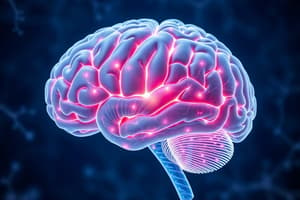Podcast
Questions and Answers
What aspect of the cerebellum is crucial according to Galen's findings?
What aspect of the cerebellum is crucial according to Galen's findings?
- It helps in coordinating movement. (correct)
- It regulates the body's humors.
- It is responsible for sensation and memory.
- It is involved in the production of cerebrospinal fluid.
Which structure did Galen discover that contains cerebrospinal fluid?
Which structure did Galen discover that contains cerebrospinal fluid?
- Sulci
- Ventricles (correct)
- Cortex
- Gyri
What does phrenology propose about the skull's shape and size?
What does phrenology propose about the skull's shape and size?
- It reflects individual traits and characteristics. (correct)
- It determines physical health only.
- It indicates intelligence levels.
- It's unrelated to personality traits.
Which type of synapse is characterized by a spherical shape and promotes neuron firing?
Which type of synapse is characterized by a spherical shape and promotes neuron firing?
What role do glial cells play according to recent research?
What role do glial cells play according to recent research?
What is the main function of projection neurons?
What is the main function of projection neurons?
Which of the following structures in the brain are responsible for the local regulation of neuron activity?
Which of the following structures in the brain are responsible for the local regulation of neuron activity?
What did Galen relate cerebrospinal fluid movement to?
What did Galen relate cerebrospinal fluid movement to?
What did Galen assert about the cerebrum's structure and its functions?
What did Galen assert about the cerebrum's structure and its functions?
What defines Type II Inhibitory synapses?
What defines Type II Inhibitory synapses?
What allows myelinated axons to speed up electrical impulse transmission?
What allows myelinated axons to speed up electrical impulse transmission?
What happens when an electrical impulse reaches the axon terminals of a neuron?
What happens when an electrical impulse reaches the axon terminals of a neuron?
Which of the following is NOT a characteristic of neurotransmitters?
Which of the following is NOT a characteristic of neurotransmitters?
How do ligand-gated channels function in neurotransmission?
How do ligand-gated channels function in neurotransmission?
What effect does glutamate binding to its receptor have on a postsynaptic neuron?
What effect does glutamate binding to its receptor have on a postsynaptic neuron?
In neurohormonal signaling, how do neurons communicate?
In neurohormonal signaling, how do neurons communicate?
When acetylcholine binds to its receptor at the neuromuscular junction, what occurs?
When acetylcholine binds to its receptor at the neuromuscular junction, what occurs?
What is the role of Ca2+ in neurotransmitter release?
What is the role of Ca2+ in neurotransmitter release?
Which type of signaling allows for direct electrical communication between cells?
Which type of signaling allows for direct electrical communication between cells?
What is primarily affected by the change in electrical charge due to neurotransmitter binding?
What is primarily affected by the change in electrical charge due to neurotransmitter binding?
Flashcards are hidden until you start studying
Study Notes
Early Insights into the Brain
- Galen, a Greek physician, gained medical knowledge from gladiators and animal dissections.
- He deduced function from structure, suggesting the soft cerebrum was involved in sensation and memory, while the hard cerebellum controlled muscles and movement.
- Galen discovered the brain's ventricles, which contain cerebrospinal fluid.
- He linked this fluid to ancient beliefs about bodily humors (blood, phlegm, yellow bile, and black bile), suggesting they flowed through nerves to cause sensation.
Phrenology and the Shape of the Brain
- Phrenology proposed that the size and shape of the skull's "organs" revealed individual traits and characteristics.
- Gall believed different behavioral traits were linked to the size of specific parts of the skull.
Brain Structure and Function
- The cerebellum coordinates movement.
- Bumps on the brain are known as gyri.
- Grooves on the brain are known as sulci or fissures.
Understanding the Neuron
- The Neuron Doctrine distinguishes different types of synapses.
- Type I excitatory synapses are spherical and promote neuron firing.
- Type II inhibitory synapses are flattened and inhibit neuron firing.
- Projection neurons have long axons and send signals to distant brain regions.
- Interneurons have short axons and project within specific brain regions, often inhibiting other neurons.
- Glial cells, traditionally considered for maintenance and repair, are now known to have roles in neural plasticity and other brain functions.
### How Neurons Communicate
- Axons are long projections that carry electrical impulses away from the cell body.
- Synaptic endings are axon branches that release neurotransmitters to communicate with other neurons.
- Myelinated axons are covered in a fatty sheath that speeds up electrical signal transmission.
- Neurons communicate across a synapse.
- An electrical signal in one neuron converts into a chemical signal (neurotransmitters) to reach the next neuron.
- When the electrical signal reaches the end of the axon, neurotransmitters are released.
- These chemicals cross the synapse and affect the next neuron.
- Neurons can also communicate through neurohormonal signaling, where chemicals travel through the blood, or via electrical synapses, where signals pass directly between cells.
### Characteristics of a Neurotransmitter
- Must be present in the presynaptic neuron.
- Must be released in response to presynaptic depolarization.
- Release must be Ca2+-dependent.
- Specific receptors for the substance must be present on the postsynaptic cell.
### Ligand-Gated Channels
- Ligand-gated channels are postsynaptic receptors that open when a specific neurotransmitter binds.
- This change in electrical charge in the postsynaptic cell can either excite or inhibit it.
- For example:
- Glutamate, binding to its receptor, opens sodium potassium channels, causing depolarization and exciting the cell.
- Acetylcholine at the neuromuscular junction, binding to its receptor, opens channels allowing sodium (Na+) ions to enter the muscle cell, leading to contraction.
Studying That Suits You
Use AI to generate personalized quizzes and flashcards to suit your learning preferences.




